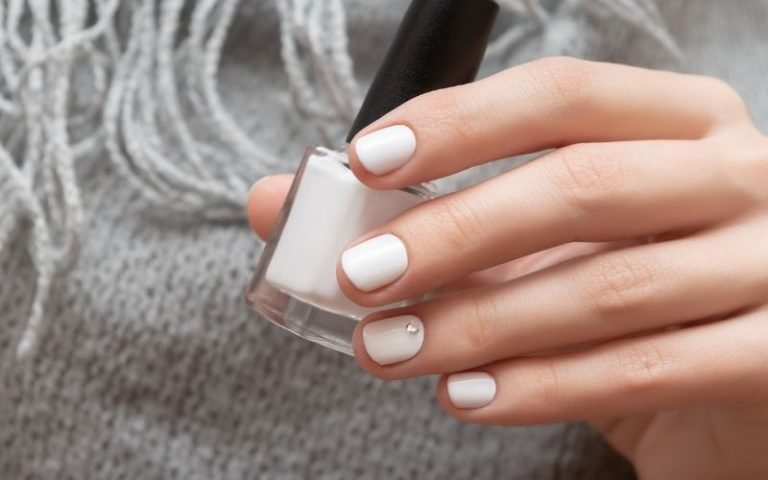Acetone Or Non-Acetone Nail Polish Remover: Which Is Best?

Spicing up the beauty of your nails with colors like pink, black, and orange adds a graceful touch to your physical characteristics. But these colors and artworks need to be removed frequently to match your fashion statement with the recent trends. There are various options available for removing nail polish. One of the most common methods is nail polish remover.
When you enter a sales outlet for a nail polish remover, the most haunting question that often strikes your mind is, “Which is best; acetone or non-acetone nail polish remover?”. The purpose and use of both these options are the same, but the differentiation revolves around how it works and how your nails feel.
Here we explore the key differences between nail polish removers with and without acetone and give you essential insights for selecting a quality nail polish remover. The alternative ideas for removing nail polish help you find the fast, gentle, and effective solution that is kinder to your nails and skin.
Table Of Contents
- Acetone Nail Polish Remover
- Non-Acetone Nail Polish Remover
- Nail Polish Remover With And Without Acetone: Differences
- How Do You Select A Quality Nail Polish Remover?
- Alternative Methods For Removing Nail Polish Without Remover
- Pick One That Balances All Your Needs
Acetone Nail Polish Remover
Acetone nail enamel remover is a type of nail polish remover that contains the chemical compound acetone as its active ingredient. Acetone is a strong and highly effective solvent that quickly breaks down the chemical bonds in nail polish, allowing for easy removal.
When applied to the nails, acetone penetrates the layers of the polish, causing it to dissolve and become liquid. This allows the polish to be easily wiped or removed from the nails using a cotton pad or cloth.
Composition Of Acetone Nail Polish Remover
Acetone nail polish remover composition typically includes:
- Acetone: Acetone is the primary active element in acetone nail polish remover. It is a strong and highly effective solvent that quickly breaks down and dissolves nail polish.
- Ethyl Acetate: Ethyl acetate is often added to acetone nail polish removers to enhance its solvent properties. It helps in dissolving the nail polish and contributes to the product’s overall effectiveness.
- Isopropyl Alcohol: Some acetone nail polish removers may contain isopropyl alcohol, which aids in the removal process by helping to break down the nail polish.
- Fragrance: To mask the strong smell of acetone, fragrance is often added to nail polish removers. It provides a more pleasant scent during use.
It’s essential to note that different brands may have slight variations in their formulations, but these are the common ingredients found in acetone-based nail polish removers.
Effects Of Acetone Nail Polish Remover On Nails
While acetone serves as an effective nail polish remover, it is crucial to be mindful of its potential impact on your nails. Acetone can lead to dryness and brittleness, rendering your nails more susceptible to breakage. It can also damage your cuticles and the skin around your nails, causing irritation and redness.
Frequent use of acetone nail polish remover may result in the discoloration of your nails or a yellowish tint becoming noticeable. This is because acetone can strip away the natural oils from your nails, leaving them exposed to external elements.
Non-Acetone Nail Polish Remover
Non-acetone nail polish remover is an alternative type of nail polish remover that does not contain acetone as its primary ingredient. Instead, it typically utilizes milder solvents, such as ethyl acetate or propylene carbonate, to dissolve and remove nail polish.
While not as strong as acetone, non-acetone removers are effective in removing regular nail polish.
Composition Of Non-Acetone Nail Polish Remover
Non-acetone nail polish remover is an alternative to acetone-based removers and is often marketed as a gentler option. The composition of non-acetone nail polish remover typically includes:
- Ethyl Acetate: Ethyl acetate is the primary active ingredient in non-acetone nail polish remover. It is a milder solvent compared to acetone and is effective in breaking down and removing nail polish.
- Isopropyl Alcohol: Non-acetone removers may also contain isopropyl alcohol, which aids in dissolving the nail polish.
- Propylene Carbonate: Propylene carbonate is sometimes added to non-acetone nail polish removers to enhance their effectiveness in removing nail polish.
- Glycerin or Emollients: To counteract the drying effects of the solvents, non-acetone removers may contain ingredients like glycerin or other emollients. These help to moisturize the nails and prevent excessive dryness.
Non-acetone nail polish removers are generally considered to be less harsh on the nails compared to acetone-based removers.
Effects Of Non-Acetone Nail Polish Remover On Nails
Non-acetone nail polish remover is generally considered to be less damaging to your nails than acetone. It’s less harsh and won’t dry out your nails or cause them to become brittle. However, non-acetone nail polish remover can still cause some damage if used frequently or improperly.
If you use non-acetone nail polish remover frequently, you may notice that your nails become dry or discolored. This is because some non-acetone nail polish removers contain harsh chemicals, such as phthalates, which can be harmful to your nails.
Nail Polish Remover With And Without Acetone: Differences
To choose the best one that fills all your needs, you should know the key differences between acetone and non-acetone nail polish removers. Here are some.
- Strength: Acetone-based removers are stronger and more effective in removing nail polish. One disadvantage here is that it removes natural oils from your nail bed. At the same time, non-acetone remover is a gentler option for your nails.
- Effect On Nail And Skin: Acetone nail polish removers may dry out your skin and nails, while non-acetone nail polish removers do not do that.
- Speed: Pure acetone nail polish remover moves out your old nail polish quickly, while acetone-free nail polish removers take a little more time to do that.
- Chemical Composition: Acetone-containing nail polish remover is a strong formula that works harshly on your nails. At the same time, non-acetone removers use gentler solvents such as ethyl acetate, isopropyl alcohol, and propylene carbonate that show less tendency to dehydrate and discolor your nails.
- Smell: Acetone-based nail polish remover has a strong and pungent smell, while non-acetone removers have a milder and less effective scent.
- Flammability: Nail polish removers containing acetone are flammable that easily catch fire, while this chance is less in non-acetone removers.
- Availability: Acetone nail polish removers are widely available, but you have to spend some time finding a non-acetone nail polish remover.
- Price: Non-acetone nail polish remover is a little more expensive than one that contains acetone.
How Do You Select A Quality Nail Polish Remover?
While buying a nail polish remover, consider the following elements. These professional tips may help you find the best nail polish remover for your needs.
- Purpose: First, analyze why you need a nail polish remover. If you want a fast-acting remover, go for acetone-based. If you want a gentler one, choose a non-acetone-based remover.
- Ingredients: Look for nail polish removers that contain nourishing ingredients such as vitamins and moisturizers to prevent nail and skin dryness.
- Brand: Choose a popular and reputable brand with good customer feedback and a proven track record.
- Packaging: Select a remover with convenient and spill-proof packaging.
- Price: High-quality nail polish removers can be more expensive. So, do not go for a less expensive option.
- Safety: Check the product label and identify the chemicals it contains. Ensure that the particular product does not contain any harmful chemicals.
For french nails, ombre nails, or acrylic nails, the initial and essential step is nail preparation (removing the oil nail polish using a remover). So be specific in this always.
Alternative Methods For Removing Nail Polish Without Remover
Some common questions most people ask are “how to take nail polish off without a nail polish remover” and “what can I use instead of a nail polish remover”. Here is a simple and valuable answer to all your questions.
Yes, there are various alternatives. Here are some.
- Nail Polish: The best nail enamel remover would be to use the nail polish itself. Just apply a coating on the painted nails, allow it to dissolve and then wipe it off with cotton.
- Rubbing Alcohol: You can use rubbing alcohol as a nail polish remover alternative. Soak a small cloth in rubbing alcohol, hold it on your nails that are painted for a few seconds, and then wipe it off.
- Alcohol-Based Perfumes: Soak a cotton ball in alcohol-based perfume. Hold the soaked cotton ball on your fingernails for a few seconds to wipe off the nail polish. Repeat the same process if needed.
- Hand Sanitizer: Dip a cloth in a small amount of hand sanitizer and wipe off your nail polish.
- Lemon Juice And Baking Soda: Mix equal parts of lemon juice and baking soda. Rub off your nail polish with a cotton piece dipped in this mixture.
- White Vinegar: Soak a piece of cotton in white vinegar and hold it on your polished nails for a few seconds.
- Nail Polish Thinner: Pour a small amount of nail polish thinner on a cotton ball, and use it to remove the polish.
Even though these alternatives are gentler and less expensive, they may take longer to show you a result. Additionally, these options may not ensure you a smooth finish.
Pick One That Balances All Your Needs
Selecting the right nail polish remover can take time and effort. But you can make it simple with a better understanding of the differences between removers with and without acetone. Whether you prefer a fast-acting, acetone-based remover or a gentler, non-acetone alternative, the most important thing is to find a solution that works for you and your specific needs.
Take your time, research various brands, and choose the best nail polish remover to keep your nails and cuticles healthy and beautiful.
FAQs
Q: Is nail polish remover bad for natural nails?
A: The answer is yes and no. Overuse of nail polish remover dries out and damages your natural nails. So, you better use it sparingly and moisturize your nails after every use.
Q: Is it good to use nail polish remover on artificial nails?
A: Yes, nail polish remover can be used on artificial nails.
References
- https://www.self.com/story/to-acetone-or-not-the-healthie#:
- https://www.sheknows.com/living/articles/1073747/nail-polish-removers-what-you-should-know/
- https://www.sinclairdermatology.com.au/explainer-whats-the-deal-with-acetone-nail-polish-remover-and-is-it-bad-for-your-nails/
- https://health.howstuffworks.com/skin-care/nail-care/tips/non-acetone-nail-polish-remover.htm
- https://www.theyouth.in/2020/12/27/acetone-vs-non-acetone-nail-polish-remover-which-one-is-better/





